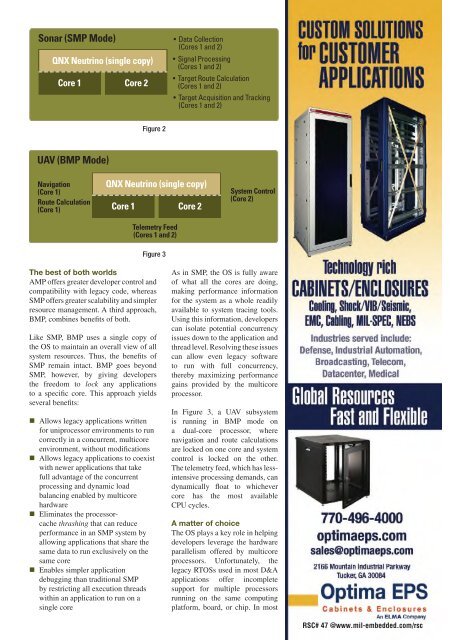Military Embedded Systems Summer 2006
Military Embedded Systems Summer 2006
Military Embedded Systems Summer 2006
You also want an ePaper? Increase the reach of your titles
YUMPU automatically turns print PDFs into web optimized ePapers that Google loves.
Sonar UAV (BMP (SMP Mode)<br />
QNX Neutrino (single QNX Neutrino copy) (single copy)<br />
Navigation<br />
(Core 1)<br />
Route Calculation<br />
(Core 1)<br />
• Data Collection<br />
(Cores 1 and 2)<br />
Core 1 Core Core 1 2 Core 2<br />
• Signal Processing<br />
(Cores 1 and 2) System Control<br />
• Target Route Calculation (Core 2)<br />
(Cores 1 and 2)<br />
• Target Acquisition and Tracking<br />
Telemetry Feed(Cores 1 and 2)<br />
(Core 1 or 2)<br />
Figure 2<br />
UAV (BMP Mode)<br />
Navigation<br />
(Core 1)<br />
Route Calculation<br />
(Core 1)<br />
QNX Neutrino (single copy)<br />
Core 1 Core 2<br />
Telemetry Feed<br />
(Cores 1 and 2)<br />
System Control<br />
(Core 2)<br />
Figure 3<br />
The best of both worlds<br />
AMP offers greater developer control and<br />
compatibility with legacy code, whereas<br />
SMP offers greater scalability and simpler<br />
resource management. A third approach,<br />
BMP, combines benefits of both.<br />
Like SMP, BMP uses a single copy of<br />
the OS to maintain an overall view of all<br />
system resources. Thus, the benefits of<br />
SMP remain intact. BMP goes beyond<br />
SMP, however, by giving developers<br />
the freedom to lock any applications<br />
to a specific core. This approach yields<br />
several benefits:<br />
• Allows legacy applications written<br />
for uniprocessor environments to run<br />
correctly in a concurrent, multicore<br />
environment, without modifications<br />
• Allows legacy applications to coexist<br />
with newer applications that take<br />
full advantage of the concurrent<br />
processing and dynamic load<br />
balancing enabled by multicore<br />
hardware<br />
• Eliminates the processorcache<br />
thrashing that can reduce<br />
performance in an SMP system by<br />
allowing applications that share the<br />
same data to run exclusively on the<br />
same core<br />
• Enables simpler application<br />
debugging than traditional SMP<br />
by restricting all execution threads<br />
within an application to run on a<br />
single core<br />
As in SMP, the OS is fully aware<br />
of what all the cores are doing,<br />
making performance information<br />
for the system as a whole readily<br />
available to system tracing tools.<br />
Using this information, developers<br />
can isolate potential concurrency<br />
issues down to the application and<br />
thread level. Resolving these issues<br />
can allow even legacy software<br />
to run with full concurrency,<br />
thereby maximizing performance<br />
gains provided by the multicore<br />
processor.<br />
In Figure 3, a UAV subsystem<br />
is running in BMP mode on<br />
a dual-core processor, where<br />
navigation and route calculations<br />
are locked on one core and system<br />
control is locked on the other.<br />
The telemetry feed, which has lessintensive<br />
processing demands, can<br />
dynamically float to whichever<br />
core has the most available<br />
CPU cycles.<br />
A matter of choice<br />
The OS plays a key role in helping<br />
developers leverage the hardware<br />
parallelism offered by multicore<br />
processors. Unfortunately, the<br />
legacy RTOSs used in most D&A<br />
applications offer incomplete<br />
support for multiple processors<br />
running on the same computing<br />
platform, board, or chip. In most<br />
RSC# 47 @www.mil-embedded.com/rsc
















